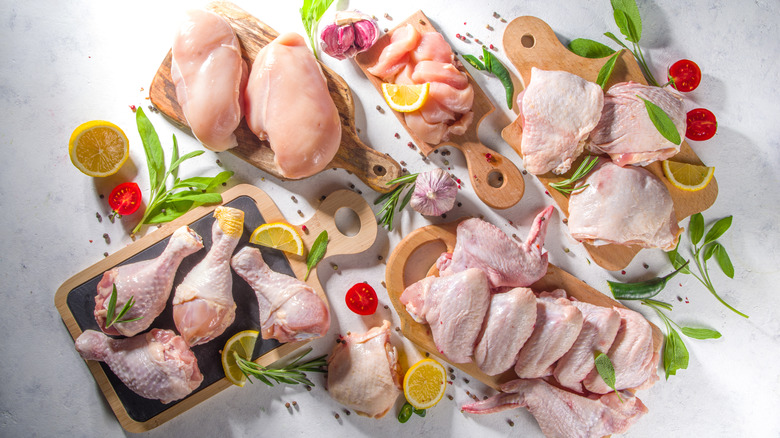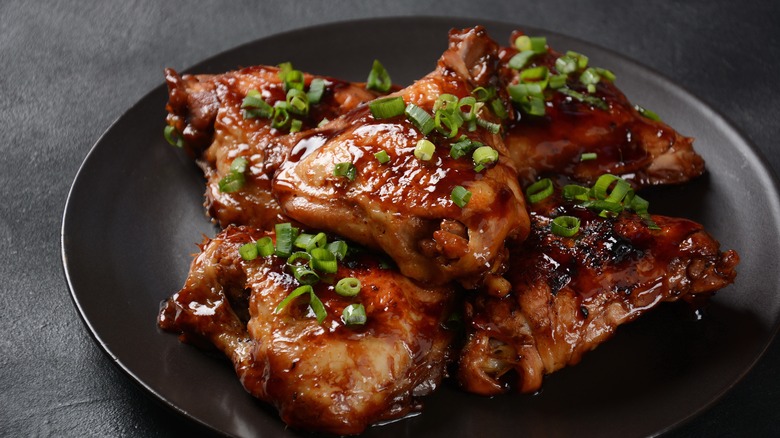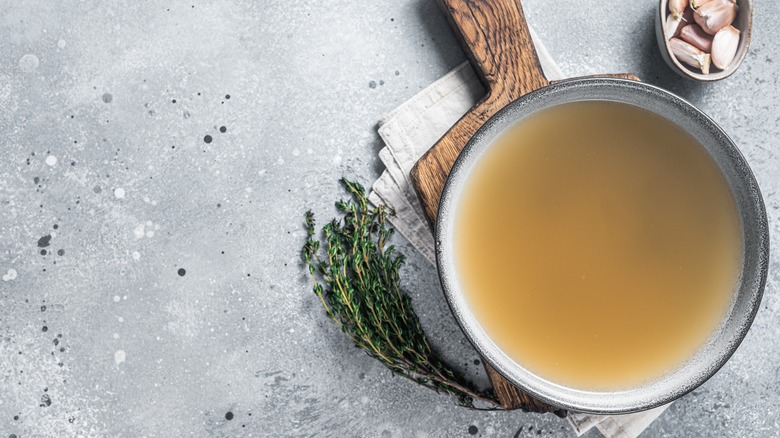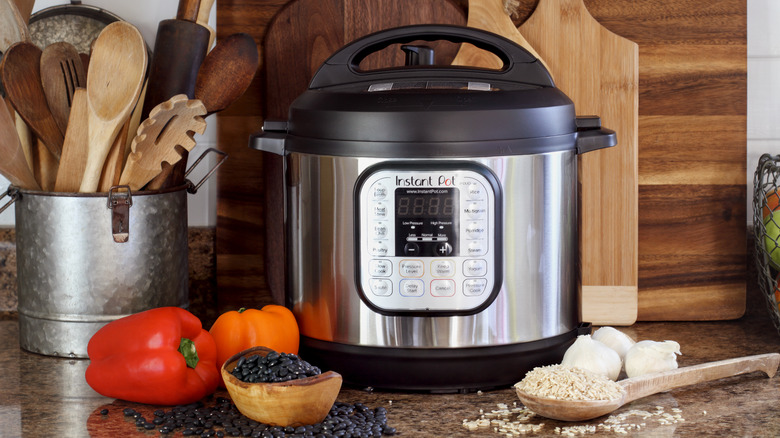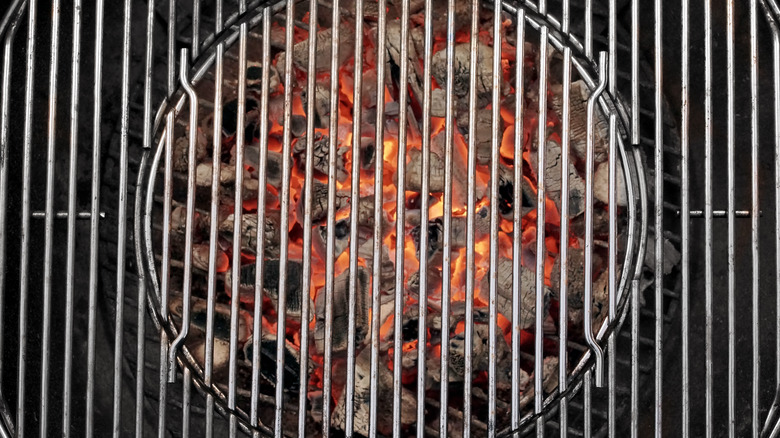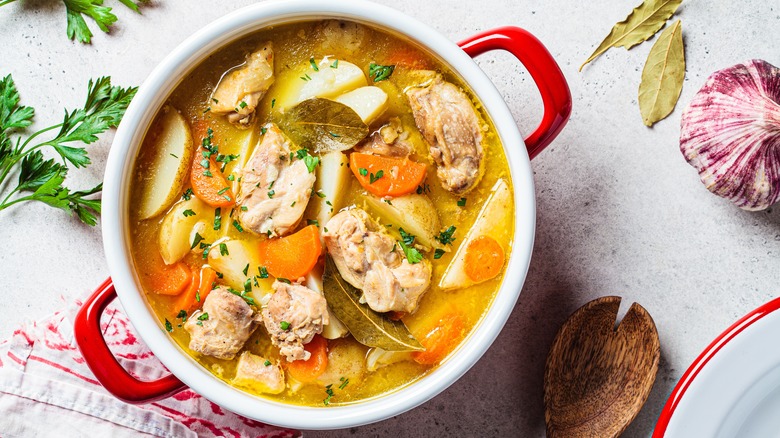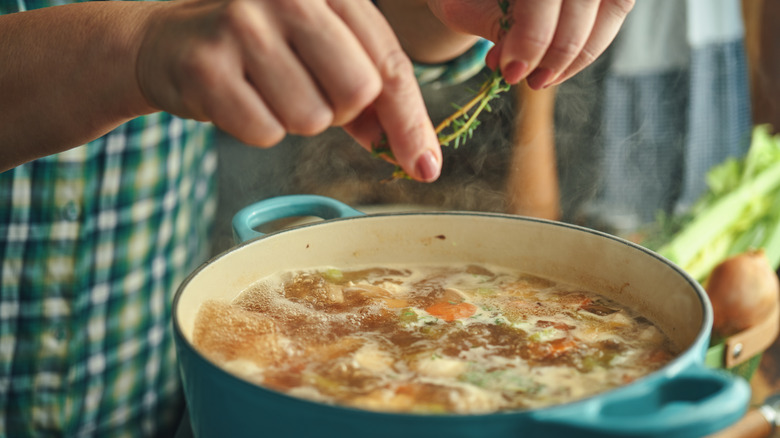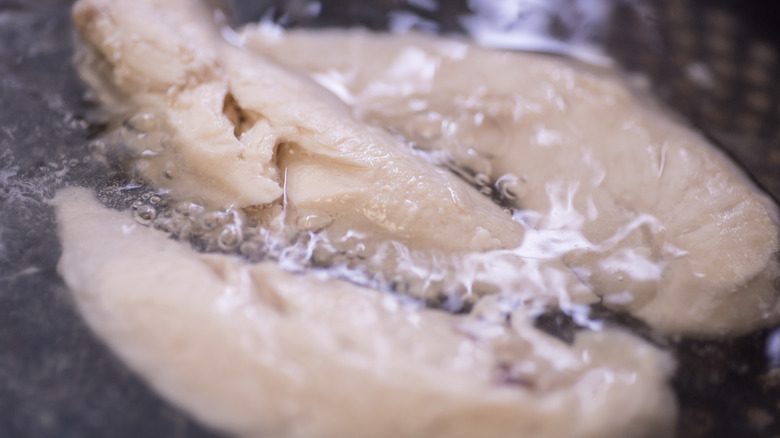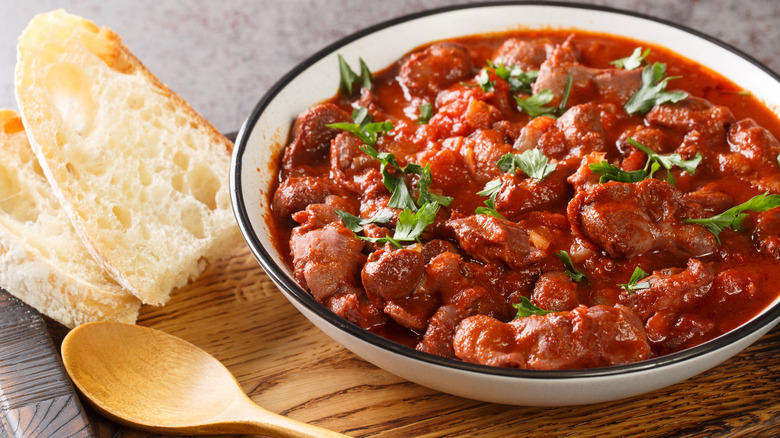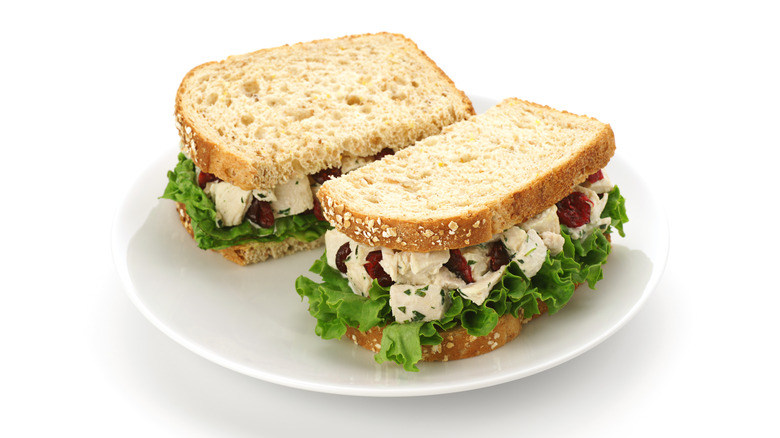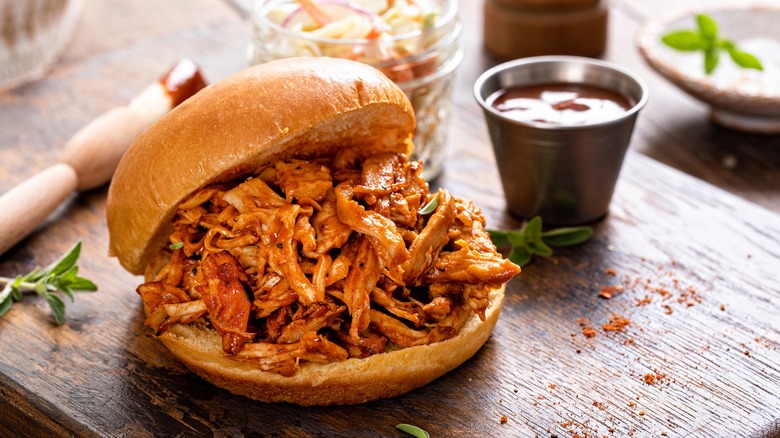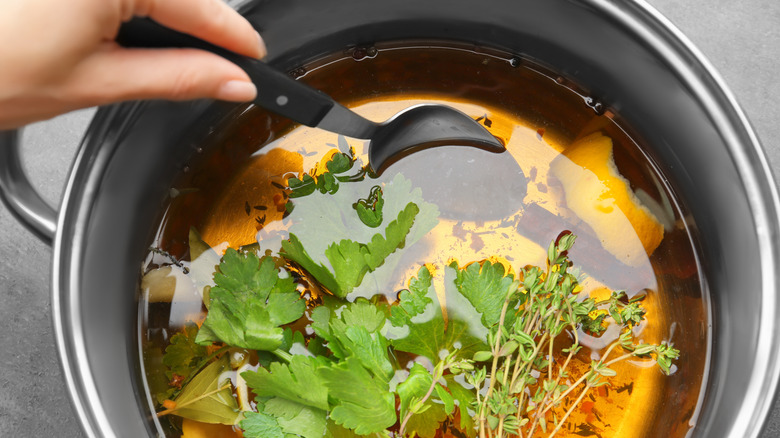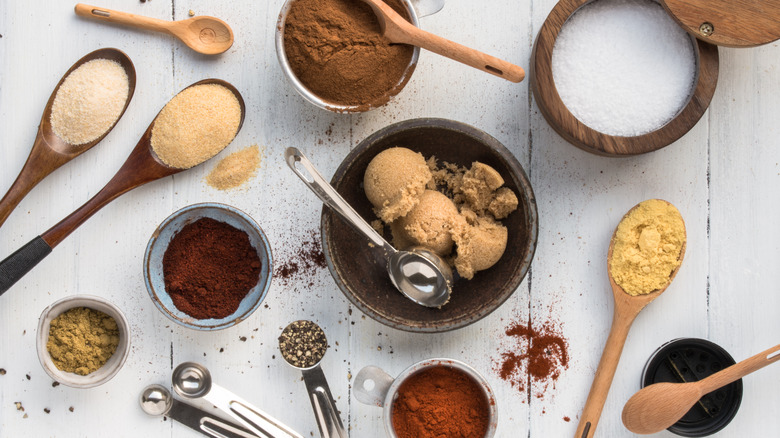13 Simple Ways To Improve A Cheap Cut Of Chicken
When it comes to chicken, there are decidedly two kinds of people: those who prefer white meat and those who like dark (vegetarians and vegans excluded, of course). Cuts of poultry are divided up in a similar manner in the supermarket. The differences in textures and tastes are quite clear. The darker meat — generally the legs, thighs, and wings — is made darker by the frequency of sustained muscle usage. Standing and flapping clearly explain why the legs and wings are a much deeper color than a chicken's breasts. Simultaneously, the darker pieces tend to be more cost-efficient, selling for significantly cheaper in the grocery store than breast meat.
The cost difference and flavor preference primarily come down to the makeup of each muscle group. White meat, made up of mostly white fibers, is leaner with fewer calories and slightly more protein — both deemed more valuable in today's market, hence the higher price. It also tends to have a lighter, more delicate flavor. Meanwhile, the darker, most cost-effectively priced cuts of meat are made up of predominantly red fibers, which contain more fat, zinc, iron, and vitamin C. Dark meat also tends to have a deeper, richer flavor.
For those who love nothing more than a wing-eating session or tucking into a drumstick fresh off the grill, this list is for you. Here are some ways to make the most out of those juicy thighs, wings, and legs.
1. Try braising
There's something about braising anything, from chicken to meat to vegetables, that feels nurturing, giving a bit of tender loving care to the food and to those who will eat it. Maybe it's the slow nature of the technique, using heat that's not too high or low. Or perhaps it's the constant attention the cook gives, gently spooning the braising liquids over the ingredients at various points during the cooking process. Whatever it is, braising feels like gently coaxing the best out of each component, not too demanding, but with constant, loving attention. The results reflect this care.
Braising can take tough cuts of meat and turn them into the most velvety stews. It is also a brilliant technique to use when cooking the cheaper cuts of chicken, like the wings, drumsticks, and thighs. If you're braising chicken with skin, we recommend laying the chicken skin-side-down in a single layer to help sear and brown the skin without overcrowding the pan. Some recipes include directions to remove the chicken before adding aromatics and deglaze the pan before nestling the chicken pieces back in, skin-side-up, to simmer away until tender and rich with flavor.
2. Make a stock or bone broth
Research on the many benefits of bone broth is clear; for those who eat meat, drinking broth made from animal bones (rather than a stock cube) can be hugely beneficial. Depending on what animal bones you use, the nutrient-dense broth can be rich in collagen, iron, and amino acids, which can aid with digestion, sleep, and joint health, per BBC Good Food.
Whether you're using chicken wings, drumsticks, or thighs, a slow cooker or pressure cooker can be your friend in making the process more hands-off while using less energy throughout the cooking process. Add dark meat, bone-in, and a few vegetables, herbs, and aromatics to your Instant Pot, and set it for just over 30 minutes on a high-pressure setting. Once it's cooked and cooled, strain the stock, pick out the tender chicken for a separate meal, and sip away on a collagen-enriching, delicious drink. Bone broth is also perfect for freezing and use later in your favorite recipe for matzoh ball or chicken noodle soup.
3. Use a pressure cooker
Pressure cookers are fantastic tools that can take ingredients from tough to tender in minutes. Want to make pulled chicken tinga? Fancy a tender barbecue sauce-laden chicken sandwich? Throw those saucy thighs into a pressure cooker and let science do the work. Pressure cookers are a wonderful way to take ingredients that might be naturally tough, including a variety of cheaper cuts of meat or fibrous legumes, fruits, and vegetables, and turn them into fork-tender meals, with most of the work being hands-off. You can also use this versatile piece of equipment to make bone broth or stock; both are excellent ways to use the carcass or cheaper cuts (namely the dark meat) of chicken.
There are a few things to note about using pressure cookers, such as an Instant Pot or others like it. Only use the quick-release button for dishes with small amounts of water or liquid. Otherwise, they tend to create a sputtery, spluttery mess. If using your pressure cooker for stews or soups, a gentle release by letting the equipment naturally cool on its own is advised.
4. Finish wings on the grill
We're not entirely sure why chicken wings are so closely connected with spectator sporting events like tailgating or the Super Bowl, but we're happy to embrace the connection. After all, when it comes to wings, more is more.
There are many great ways to take chicken wings from their raw state to a perfectly executed finished product. You can opt to just use the grill and cook with a combination of direct and indirect heat. This means getting a good set of tongs, then beginning the cooking process on a cooler portion of the grill, covering it with a lid, and cooking for around ten minutes or so, ensuring the inside of the meat cooks through. This process can also be achieved in a low oven, slow cooker, or pressure cooker like an Instant Pot to ensure the meat is tender.
After using either the grill's indirect heat or another method, it's time to turn the dial on the heat volume up to eleven. Move your previously marinated, well-cooked chicken wings to a more direct heat, placing them on the hottest part of the grill to get the skin flame-licked and crispy. You'll want to keep a good eye on the pieces, turning them over frequently to avoid burning. Once they're good and crispy, remove them and dig in.
5. Slow cook a stew
When it comes to animal proteins, two factors contribute significantly to the flavor and tenderness of a cut of meat. First, consider how much the animal's muscle is used; the tougher the cut, the more significant its workhorse-like status. The second thing to consider is the amount of fat in and around the muscle fibers. When it comes to meat, fat = flavor.
While chicken breasts are fine to use in slow-cooked stews, they are the leanest cut of the bird and tend to dry out quickly. Simultaneously, because of the lack of fat, the flavor is much more delicate and light than the animal's thighs, legs, and wings. Though great for schnitzel or a grilled chicken sandwich, when it comes to a rich-tasting stew, we recommend using the darker, cheaper cuts of meat. They're naturally better for slower-cooked dishes like stews and also work to produce more flavorful results than when using chicken breast. The key difference between a stew and a soup literally boils down to the amount of liquid. Don't be afraid to reduce your liquid base until you achieve a thicker, more flavorful, more gravy-like consistency before serving up your chunky chicken stew.
6. Use the carcass in a soup
We think there are two life skills every chicken eater (and, therefore, cook) should learn in the kitchen. These two specific skills will see any cook through numerous occasions and obstacles, from impressing the in-laws to saving a bit of money. Chicken lovers will benefit from learning how to roast a whole chicken. Not only does a whole roasted chicken make an impressive show-stopper to set at the table, but it also appeals to white meat and dark meat eater in one fell swoop for significantly less money than buying both types of meat separately.
Whole chickens are often significantly less money per pound compared to the cost of buying individually prepared breasts. Once jointed, not only do you have individual pieces for the grill, a stew, or the oven, but you are also left with a glorious and undervalued carcass, perfect for making a rich and versatile soup.
Depending on the kind of broth you wish to make, you can either use the carcass raw, as is, or you can roast the bones in the oven, or use the remains of your roast chicken dinner and any leftover jus or other subsequent bones or meat, to create a darker, richer stock.
7. Poach in aromatics
Over the last several years, poached eggs have found their 15 minutes of fame on brunch menus and Instagram posts across the U.S., thus answering the age-old question of which came first. It seems only right that the popularity of poached chicken should follow suit. Poached chicken is a staple dish across Asia, accounting for some of the most beloved meals like Hainanese chicken, a favorite of the late Anthony Bourdain.
The secret to a flavorful poached chicken dish is not just the chicken itself (though the happier the chicken's life before it hit the supermarket shelves, the better) but the poaching liquor or liquid. The idea is to infuse the meat with plenty of aromatics from its surrounding liquid, so a light-handed approach is not recommended in this instance. The darker, richer meat can handle the flavor, so consider adding whole spices like star anise, cloves, garlic, and ginger or strong flavors like soy, lemon, or vinegar to really build flavor. Poaching is also a great way to gently cook food without worrying about drying it out, just so long as the water is kept to a low simmer rather than a rapid boil. Thighs work best in this instance, which can then be served as is over rice or shredded for later use in curries, soups, or tacos.
8. Slow cook for maximum flavor
Despite so much of today's messaging suggesting that we should all be moving at the speed of light, some things are far better when taken slowly, from a scenic drive to a chicken dinner. Slow-cooked chicken thighs are a perfect example of the benefits of slowing down. Their fat-to-meat ratio and red muscle fibers are perfectly designed, almost as if by nature, for slow cooking, stewing, and roasting, as their flavor only deepens and intensifies. Their texture also softens and silkens, thanks to their naturally high yield of gelatine, the longer chicken thighs are cooked.
To make the most out of your next pack of chicken thighs, choose ones that still have the skin on and the bones in. Not only will this make for a richer flavor when cooking, but de-boning the meat yourself will also save you money without much extra work. You can then slowly cook the thighs on low heat in the oven, on the stove, or in a slow cooker or crock pot. As they cook, they will naturally continue to soften and tenderize, making for a rich and luxurious mouth feel and a satisfying meal.
9. Chop up for chicken salad
Though not much could be more comforting than a roast chicken and potato dinner on a blustery winter's day, chicken is an all-seasons food. The humble bird makes some of summer's best meals, from crispy wings fresh off the grill to a cold chicken salad piled high between two slices of bread. While white meat does make for a wonderfully light sandwich filling, darker meats like juicy chicken thighs shouldn't be overlooked.
To create the ultimate chicken salad sandwich from your chicken thighs, consider marinating the thighs for a few hours or overnight in something acidic, like lemon juice, yogurt or buttermilk, Italian salad dressing, or even pickle juice, mixed with oil for balance. Next, gently poach the thighs to create a soft-but-firm texture. Depending on personal preferences, you can then shred the chicken or chop it into cubes, and cool it before mixing it with mayo, yogurt, or even avocados. Season well then scoop it into lettuce cups, onto a croissant, or in between a thin flour wrap to make the ultimate picnic lunch. Enhancing the salad with textural and flavor variations like the crunch of a vegetable or perk of a pickle will only add to the overall experience, so do raid the fridge for whatever is on hand!
10. Make a slow-cooked pulled chicken
"Set it and forget it" is the theme of this kind of cooking, all thanks to the mid-week-meal workhorse we call the slow cooker. As mentioned earlier, the darker meats of the chicken, thighs in particular, were practically made for slow cooking. The higher fats and gelatine found in this specific part of a chicken's body become the secret ingredient in creating a fork-tender texture that gets silkier and more satisfying the longer it cooks.
While this tender texture is fantastic when the thighs are kept whole, say marinated with soy and honey and served over rice, it also lends itself to making a delicious pulled chicken with just a slight tug of the fork. There are plenty of ways to season and serve your next vat of slow-cooked pulled chicken; it's the perfect filling for soft flour tortillas or slathering with barbecue sauce and scooping up with a piece of white bread, and a table heaving with corn, coleslaw, and all of your favorite barbecue side dishes.
11. Don't forget a marinade
Would you paint your walls a new color without first adding a base coat, or even consider building a house without first laying down the foundation? Of course not. Well, the same should be true when it comes to marinating especially tougher or chewier meats before cooking.
Many will already know that marinating food before cooking will add depth of flavor to whatever the ingredient, but that's not all; the work of a marinade is two-fold. One of the ways in which it can add flavor is through the use of acidity, which works to break down proteins, creating pockets of space for flavors, such as herbs and seasoning, and creating tender results. Acids like yogurt are especially good at this task, thanks to their gentle levels of acidity, which is probably why yogurt-marinated meat is a much-loved dish across many cuisines from Greek to Indian. Add even more flavor to a yogurt marinated by stirring in fresh herbs like thyme or rosemary. Try citruses like lemon, lime, or orange zest. Or, play with warming spices like cumin, cayenne, or curry powder, depending on which region of the world you're cooking from.
12. Brine before cooking
Whether you're a novice or an expert in the kitchen, this is one of the best pieces of advice for taking a good chicken dish of any kind and making it great. One word: brine.
Brining has become the go-to first step across poultry cooking as a whole, from Thanksgiving turkeys to drumsticks on the grill. While it is an especially moisture and flavor-enhancing technique for cuts of poultry like breasts, which can easily dry out due to their lack of fat, brining works well with dark meat, too.
Brining works so well thanks to the salt, which helps to unwind the tight protein strands, allowing for additional moisture between each strand, resulting in juicier and, ultimately, more delicious final results. Add spices, herbs, or aromatics to your brine to infuse flavor into each bite. Whether you use a wet brine like salt water or buttermilk or a dry brine like a salt and herb rub is up to you. Either way, you'll only add moisture and flavor to the dish, giving new meaning to the phrase "winner, winner, chicken dinner".
13. Spice rub the skin
There's nothing quite like biting into a piece of tender, juicy chicken protected by a wall of well-seasoned, crispy skin. For those looking to enhance that duel-textural pleasure, a spice rub is one of your best tools for success for several reasons.
The first step to making crunchy chicken skin is working to extract moisture. You can do this in three stages: first, pat the skin dry, then rub it with salt, and leave it in the fridge uncovered for a minimum of an hour to help dry it out.
Next up, add flavor to take your chicken skin's taste from good to great. Whether you choose a mixture of dried herbs like thyme, rosemary, and fennel for more French-like flavors or try a more Middle Eastern-inspired mix of lemony's sumac, sesame seeds, and cumin, the choice is yours to make again and again every time you cook. Once you have this technique down pat, you can change it up with new flavors from across the globe to suit any chicken-based craving.
